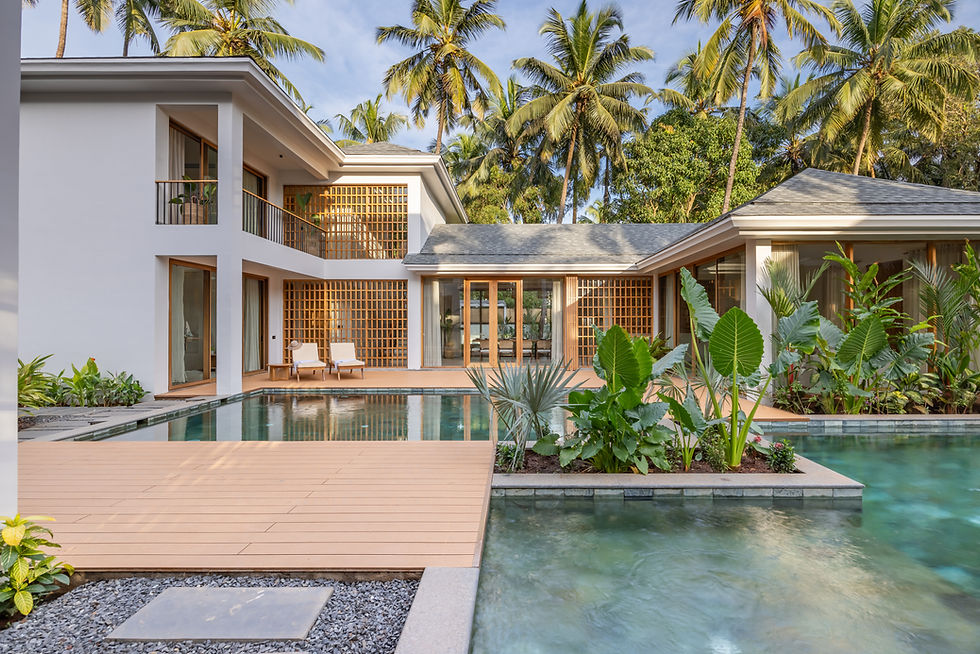MOG, the Museum of Goa | Pilerne
- Luke Sequeira

- Feb 25, 2019
- 3 min read
The Museum of Goa or MOG, which means love in Konkani, is Subodh Kerkar’s personal project. I had the privilege of visiting this museum a week before the formal inauguration and during that visit, interacted with Kerkar, the Founder Director of the museum.
Located in the Pilerne Industrial Estate in North Goa, it is an unlikely location for a museum of art; in the middle of the dusty, steely grey industrial area. But the moment you walk into the museum site, you are transported into a different world, one of landscaped gardens and eclectic artwork.

A series of blue sculptures, that seemingly pop up from the Earth, have been placed along the pathway to help the visitors find their way. These mermaids act as a guide and lead visitors to the museum entrance and also mark the nearby junctions.
The museum is spread across three floors and the galleries host paintings, sculptures, installations and video art. The museum is dedicated solely to contemporary art and since MOG doesn’t believe in permanent exhibits, the installations keep changing. Additionally, the museum also houses an auditorium, art store, art café and studio spaces.
Following the mermaids, I reached the entrance where a sculpture of a large humanoid head with a bright pink bubble-gum bubble between its lips was placed. It seemed to be a sly rendition of the monolithic sculptures of Easter Island. Originally, these sculptures were built to represent the spirits who provided for and oversaw the living. In this context, the work is meant to be a satire, representing the trajectory of human civilization from ineffable and ancient to crass and juvenile.
For me, an admirer of all things metaphorical, art is a way to fully express ones’ feelings toward a subject without really explaining anything. To be able to successfully express them without having to write about the story and thought process makes art universal; panning across barriers and limitations.
All of the work was beautiful without question and through the art I studied, it was clear to understand how these original ideas were born from the knowledge and skill the artists’ possessed.
A section of the exhibition was devoted to oil paintings which depicted the lifestyle of the Goans in bygone days. These were taken from Kerkar’s personal collection and were all painted by his father, Chandrakant Kerkar. The late artist’s’ works are a perfect documentation of the daily life of the Goa of his youth. All of the artwork stood for important causes and celebrated the ‘connected-ness’ of cultures.
Each exhibit has its own space to interact with the visitors; when one installation is being viewed, it is the only speaker telling its story.
The spaces in the museum are well spread and refined. In a way, the museum itself is a piece of art, with spaces mixing but not spilling into each other. The open spaces outside the museum also mix well with the interior spaces creating a calm and tranquil flow with defined boundaries.
On display was a photo installation of Gopakapattam, one of the significant ports of Goa, which was cited in 1341. It is located at current-day Goa Velha where the ruins are still visible, but only during low tide.
There was also an installation made on a giant metal blade used for mining which is shaped like a medal with the map of Goa and a forest carved on its surface. It speaks about the forests being lost to the mining blades.
Another installation which I found to be particularly powerful, was in the form of a row of torsos in different colors; all adorned with rosaries and the jhanvem (sacred thread). In addition to these, they had name plates with obviously mixed-cultural names that depicted the conversion history of Goa. For the Christian-brahmins, not wearing the sacred thread meant that they were lowering their social standing to those of the low castes; so they made an appeal and in 1623, the Pope made a decree that they could wear their sacred threads but only after it had been blessed by a Bishop. On the torsos, the modes of conversion are also depicted such as meat, wine etc.
This museum develops an identity for Goa, which is much more than the sun, sand and shacks for which is it visited. The voice of history and rich cultural heritage which had slowly been muffled by the alcohol and parties, has been represented and conserved in this modern and contemporary ideology.
MOG - Museum of Goa
Hours | Monday to Sunday 10am - 6pm
Article by Sharon Rebecca Jacob facebook.com/greenleafpb







Comments